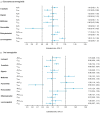Clinical Perspectives on the Use of Subcutaneous and Oral Formulations of Semaglutide
- PMID: 34267725
- PMCID: PMC8276717
- DOI: 10.3389/fendo.2021.645507
Clinical Perspectives on the Use of Subcutaneous and Oral Formulations of Semaglutide
Abstract
Early and effective glycemic control can prevent or delay the complications associated with type 2 diabetes (T2D). The benefits of glucagon-like peptide-1 receptor agonists (GLP-1RAs) are becoming increasingly recognized and they now feature prominently in international T2D treatment recommendations and guidelines across the disease continuum. However, despite providing effective glycemic control, weight loss, and a low risk of hypoglycemia, GLP-1RAs are currently underutilized in clinical practice. The long-acting GLP-1RA, semaglutide, is available for once-weekly injection and in a new once-daily oral formulation. Semaglutide is an advantageous choice for the treatment of T2D since it has greater efficacy in reducing glycated hemoglobin and body weight compared with other GLP-1RAs, has demonstrated benefits in reducing major adverse cardiovascular events, and has a favorable profile in special populations (e.g., patients with hepatic impairment or renal impairment). The oral formulation represents a useful option to help improve acceptance and adherence compared with injectable formulations for patients with a preference for oral therapy, and may lead to earlier and broader use of GLP-1RAs in the T2D treatment trajectory. Oral semaglutide should be taken on an empty stomach, which may influence the choice of formulation. As with most GLP-1RAs, initial dose escalation of semaglutide is required for both formulations to mitigate gastrointestinal adverse events. There are also specific dose instructions to follow with oral semaglutide to ensure sufficient gastric absorption. The evidence base surrounding the clinical use of semaglutide is being further expanded with trials investigating effects on diabetic retinopathy, cardiovascular outcomes, and on the common T2D comorbidities of obesity, chronic kidney disease, and non-alcoholic steatohepatitis. These will provide further information about whether the benefits of semaglutide extend to these other indications.
Keywords: glucagon-like peptide-1 receptor agonist (GLP-1RA); oral; semaglutide; subcutaneous; type 2 diabetes.
Copyright © 2021 Gallwitz and Giorgino.
Conflict of interest statement
FG has received research support from Eli Lilly, Lifescan, and Takeda, and has provided advisory services to AstraZeneca, Boehringer Ingelheim, Eli Lilly, Lifescan, Merck Sharp & Dohme, Novo Nordisk, Roche Diabetes Care, and Sanofi. BG has provided advisory services to AstraZeneca, Bayer, Boehringer Ingelheim, Eli Lilly, Merck Sharp & Dohme, and Novo Nordisk, and has received lecture honoraria from Bristol Myers Squibb and the above-mentioned companies. The authors declare that this article received funding from Novo Nordisk. The funder had the following involvement in the article: medical writing support.
Figures
References
-
- Smits MM, Van Raalte D. Safety of Semaglutide [Suppl Article].
Publication types
MeSH terms
Substances
LinkOut - more resources
Full Text Sources
Medical
Research Materials


